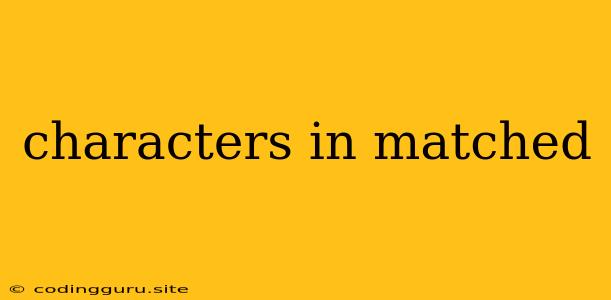Understanding Characters in Matched: A Comprehensive Guide
The concept of "characters in matched" is a crucial element in understanding the mechanics of regular expressions, a powerful tool for pattern matching and text manipulation. Regular expressions are used extensively in various programming languages and tools, allowing you to find, extract, or modify specific parts of strings based on defined patterns. Let's explore the role of characters in matched strings to understand how they influence the matching process.
What are Characters in Matched?
Characters in matched strings refer to the individual units that make up a string of text. These can include letters, numbers, punctuation marks, and special characters. When a regular expression successfully matches a string, the matched characters are the parts of the string that satisfy the pattern defined by the regular expression.
How are Characters used in Matched Strings?
The most important aspect of characters in matched strings is their role in defining patterns. Regular expressions utilize various character classes and special characters to create patterns that can match different combinations of characters.
Here are some key concepts:
- Literal characters: These are the simplest characters in a pattern. They match themselves exactly. For example, the pattern "cat" will only match the string "cat".
- Character classes: Character classes allow you to match multiple characters within a single position. For example:
[a-z]matches any lowercase letter from a to z.[0-9]matches any digit from 0 to 9.[a-zA-Z0-9]matches any letter (uppercase or lowercase) or digit.
- Metacharacters: These are special characters that have specific meanings in regular expressions, and they are used to create more complex patterns. Some common examples include:
.(dot): Matches any character except a newline.*(star): Matches zero or more occurrences of the preceding character or group.+(plus): Matches one or more occurrences of the preceding character or group.?(question mark): Matches zero or one occurrence of the preceding character or group.^(caret): Matches the beginning of a line or string.$(dollar sign): Matches the end of a line or string.
Examples of Character Matching
Here are some examples of how characters are used in matched strings:
Example 1: Simple Matching
Pattern: cat
String: The cat sat on the mat.
Matched String: cat
In this example, the pattern "cat" matches the literal string "cat" within the longer string.
Example 2: Character Class Matching
Pattern: [a-z]+
String: This is a sample string.
Matched String: This
The pattern [a-z]+ matches one or more lowercase letters. It finds the first word "This" as the matched string.
Example 3: Metacharacter Matching
Pattern: ^[A-Z][a-z]+
String: Hello World!
Matched String: Hello
The pattern ^[A-Z][a-z]+ uses the ^ character to match the beginning of the line. It also includes a character class [A-Z] to match an uppercase letter and [a-z]+ to match one or more lowercase letters. This pattern successfully matches the word "Hello".
Common Scenarios and Applications
Characters in matched strings play a vital role in several common applications:
- Data validation: You can use regular expressions to validate user input, ensuring it meets specific criteria (e.g., email addresses, phone numbers).
- Text extraction: You can use regular expressions to extract specific information from text, such as dates, prices, or phone numbers.
- Text replacement: You can use regular expressions to replace parts of a string with different characters or patterns.
- Search and replace: You can use regular expressions to search for specific patterns within text and replace them with different values.
Conclusion
Understanding the role of characters in matched strings is crucial for effectively utilizing regular expressions. By learning how to define patterns with character classes, metacharacters, and literal characters, you can accurately identify and manipulate specific parts of text data. Mastering this knowledge will allow you to leverage the power of regular expressions across various programming languages and tools, streamlining your work and enhancing your ability to handle text effectively.
